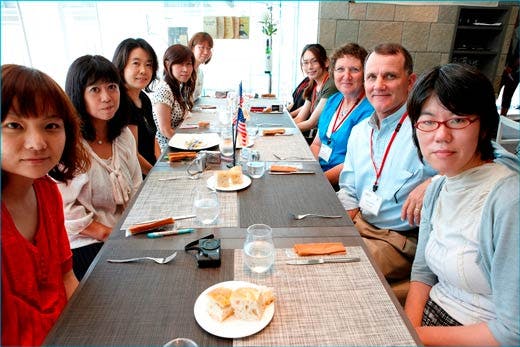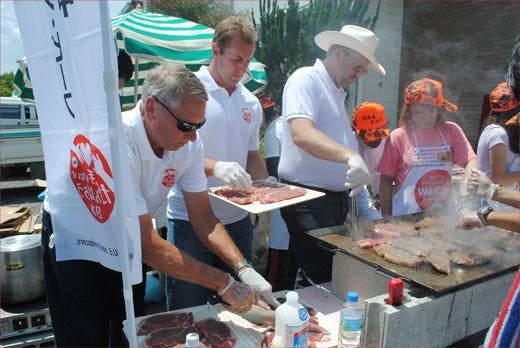Nebraska Beef, Soy, Corn Groups Visit Japan
Published: Jul 13, 2011
Delegations representing Nebraska’s beef, soybean and corn industries got an in-depth look recently at beef and pork industry programs in Japan conducted by the U.S. Meat Export Federation (USMEF), as well as the opportunity to participate in USMEF’s Japan Relief and Recovery Effort to help victims of the March earthquake and tsunami.

A meeting with a group of Japanese food industry bloggers was an eye-opener for Bill Luckey of Nebraska Soybean Board, who with his wife and four sons grows soybeans and corn, custom-feeds pigs and operates a cow-calf operation in Columbus, Neb.
“I really enjoyed the meeting with the bloggers,” said Luckey, who also serves on the board of the National Pork Producers Council. “It’s a great opportunity to put a face on our industry. We have families and we consume the same products we ship to international customers. When the bloggers meet with U.S. producers they hear that we care about our customers, the environment and producing a safe product.”
Luckey noted that each of the bloggers has 500 to 1,000 or more people following them. “When you speak with 30 or 40 bloggers about the quality and safety of U.S. beef and pork, you’re quickly reaching up to 30,000 or 40,000 readers,” he said.
Nebraska’s beef industry was represented in Japan by Bill Rhea of Arlington, Neb., the Nebraska Beef Council’s treasurer and a member of USMEF’s executive committee. He was struck by the growth opportunity for U.S. beef in Japan.
“The potential for U.S. beef is enormous,” Rhea said. “We just need to figure out how to get enough product there. We talked with management at Matsuya (Japan’s third-largest gyudon restaurant chain with more than 800 beef and rice bowl outlets), and they said that sales just jumped off the charts when they switched recently to using U.S. beef exclusively.”
In fact, Matsuya officials confirmed that sales of the gyudon are up 78 percent over the same period last year when the chain used non-U.S. beef.
“I really enjoyed the meeting with the bloggers,” said Luckey, who also serves on the board of the National Pork Producers Council. “It’s a great opportunity to put a face on our industry. We have families and we consume the same products we ship to international customers. When the bloggers meet with U.S. producers they hear that we care about our customers, the environment and producing a safe product.”
Luckey noted that each of the bloggers has 500 to 1,000 or more people following them. “When you speak with 30 or 40 bloggers about the quality and safety of U.S. beef and pork, you’re quickly reaching up to 30,000 or 40,000 readers,” he said.
Nebraska’s beef industry was represented in Japan by Bill Rhea of Arlington, Neb., the Nebraska Beef Council’s treasurer and a member of USMEF’s executive committee. He was struck by the growth opportunity for U.S. beef in Japan.
“The potential for U.S. beef is enormous,” Rhea said. “We just need to figure out how to get enough product there. We talked with management at Matsuya (Japan’s third-largest gyudon restaurant chain with more than 800 beef and rice bowl outlets), and they said that sales just jumped off the charts when they switched recently to using U.S. beef exclusively.”
In fact, Matsuya officials confirmed that sales of the gyudon are up 78 percent over the same period last year when the chain used non-U.S. beef.

Rhea and members of Nebraska Corn Board observed large USMEF promotions funded by the Nebraska Beef Council with Matsuya and convenience store chain Lawson, which is the second-largest convenience store chain in Japan with more than 9,000 outlets.
Lawson is currently conducting a month-long promotion for a U.S. beef bento (lunch) box. It expects to sell 600,000 bento boxes during the promotion. Lawson representatives told the visiting U.S. team that they are working with USMEF on a pork bento box as well.
“The cuts of beef they use for these dishes add value to U.S. beef as they would just get used for hamburger in the U.S.,” said Curt Tomasevicz, a U.S. Olympic bobsledder who accompanied the Nebraska Corn delegation.
"I found it amazing how the grocery stores aggressively marketed their beef through special promotions and tasting demos in the store,” added John Willoughby, president of the Buffalo/Hall County Corn Growers Association and part of the Nebraska Corn team. “We saw women feeding their children U.S. beef so we know it is a trusted protein source in Japan."
Luckey also praised the Japan Relief and Recovery Effort that USMEF organized and funded with more than $515,000 in contributions from organizations and individuals covering the breadth of USMEF’s membership.
“It really opens your eyes (seeing the devastation in Japan),” said Luckey. “You realize that even though the story’s out of the media, it’s still affecting a lot of people. The effects are long lasting and they’re still going to need help. The USMEF relief program is doing outstanding work, and we’re glad to be part of that program.”
Lawson is currently conducting a month-long promotion for a U.S. beef bento (lunch) box. It expects to sell 600,000 bento boxes during the promotion. Lawson representatives told the visiting U.S. team that they are working with USMEF on a pork bento box as well.
“The cuts of beef they use for these dishes add value to U.S. beef as they would just get used for hamburger in the U.S.,” said Curt Tomasevicz, a U.S. Olympic bobsledder who accompanied the Nebraska Corn delegation.
"I found it amazing how the grocery stores aggressively marketed their beef through special promotions and tasting demos in the store,” added John Willoughby, president of the Buffalo/Hall County Corn Growers Association and part of the Nebraska Corn team. “We saw women feeding their children U.S. beef so we know it is a trusted protein source in Japan."
Luckey also praised the Japan Relief and Recovery Effort that USMEF organized and funded with more than $515,000 in contributions from organizations and individuals covering the breadth of USMEF’s membership.
“It really opens your eyes (seeing the devastation in Japan),” said Luckey. “You realize that even though the story’s out of the media, it’s still affecting a lot of people. The effects are long lasting and they’re still going to need help. The USMEF relief program is doing outstanding work, and we’re glad to be part of that program.”

"In the coastal cities affected by the tsunami, it wasn’t just their houses that were taken away, but their livelihood,” said Bill Schuster, a member of the Nebraska Corn Board delegation who serves as chairman of the Aurora (Neb.) Cooperative Board of Directors. “Since many of these people were in the fishing industry, it will take time to redevelop the industry in these areas until infrastructure is redeveloped."
Rhea also returned from his trip to the devastated regions of northeastern Japan with both a healthy respect for the power of nature as well as an appreciation for the impact that USMEF’s Relief and Recovery Effort is having.
“The older people I spoke with (at the evacuation centers) were very appreciative for what we’re doing there through USMEF,” Rhea said. “That is the hardest group to influence and to get to switch their loyalty (to U.S. beef). I believe that beyond the immediate help it’s providing, this program will be good for us down the road.”
The return on investment for checkoff and USDA Market Access Program (MAP) dollars utilized in Japan through USMEF also got high marks from the Nebraska contingent.
"The U.S. is gaining (beef) market share after it had to start from zero after 2003,” said Willoughby. “If we didn’t have this program (USMEF), other markets like Australia and Argentina would take our market share."
Rhea agreed, noting that USMEF imaging programs for U.S. beef like “We Care” in Japan and “To Trust” in South Korea, along with pork programs like “Erabarete No. 1” (top imported pork as chosen by consumers) in Japan and “El Cerdo es Bueno” (pork is good) in Mexico, are vital for helping to maintain and grow exports of U.S. red meat products.
"The Nebraska Corn Board has been a supporter of USMEF since its inception,” said Kelsey Pope, the board’s ag promotion coordinator. “It’s so important for the corn industry to support the livestock industry in our state, and corn-fed red meat is a big part of that. Our board was happy to support this mission, and many in the past, so the team could see the benefits of exporting Nebraska corn-fed red meat."
Rhea also returned from his trip to the devastated regions of northeastern Japan with both a healthy respect for the power of nature as well as an appreciation for the impact that USMEF’s Relief and Recovery Effort is having.
“The older people I spoke with (at the evacuation centers) were very appreciative for what we’re doing there through USMEF,” Rhea said. “That is the hardest group to influence and to get to switch their loyalty (to U.S. beef). I believe that beyond the immediate help it’s providing, this program will be good for us down the road.”
The return on investment for checkoff and USDA Market Access Program (MAP) dollars utilized in Japan through USMEF also got high marks from the Nebraska contingent.
"The U.S. is gaining (beef) market share after it had to start from zero after 2003,” said Willoughby. “If we didn’t have this program (USMEF), other markets like Australia and Argentina would take our market share."
Rhea agreed, noting that USMEF imaging programs for U.S. beef like “We Care” in Japan and “To Trust” in South Korea, along with pork programs like “Erabarete No. 1” (top imported pork as chosen by consumers) in Japan and “El Cerdo es Bueno” (pork is good) in Mexico, are vital for helping to maintain and grow exports of U.S. red meat products.
"The Nebraska Corn Board has been a supporter of USMEF since its inception,” said Kelsey Pope, the board’s ag promotion coordinator. “It’s so important for the corn industry to support the livestock industry in our state, and corn-fed red meat is a big part of that. Our board was happy to support this mission, and many in the past, so the team could see the benefits of exporting Nebraska corn-fed red meat."
